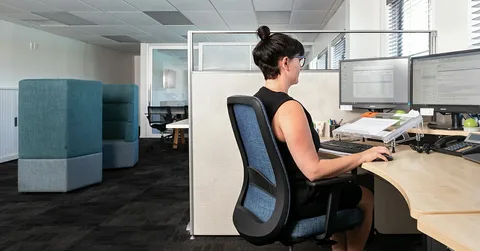Standing desk converters have gained popularity as versatile solutions for individuals seeking to improve their workstation ergonomics and combat the negative effects of prolonged sitting. However, with the abundance of options available on the market, selecting the right standing desk converter can be daunting. From overlooking important features to underestimating workspace requirements, there are several common mistakes that individuals often make when choosing a standing desk converter. In this guide, we’ll highlight these top mistakes and provide valuable insights to help you make an informed decision and maximize the benefits of your lift standing desk converter.
1. Ignoring Height Adjustment Range:
One of the most crucial aspects of a standing desk converter is its height adjustment range. Many people make the mistake of overlooking this feature and end up with a converter that doesn’t accommodate their specific height requirements. It’s essential to choose a standing desk converter with a height adjustment range that allows you to achieve proper ergonomic positioning, whether you’re sitting or standing. Consider your height, monitor setup, and keyboard placement when selecting a converter to ensure it meets your ergonomic needs effectively.
2. Not Assessing Weight Capacity:
Another common mistake is failing to assess the weight capacity of the standing desk converter. Overloading the converter with heavy monitors, laptops, or other equipment can strain the mechanism and compromise stability and safety. Before making a purchase, determine the total weight of your workstation setup and choose a converter with a weight capacity that exceeds this amount. Opting for a converter with a higher weight capacity provides an added margin of safety and ensures smooth operation even with heavier equipment.
3. Neglecting Workspace Requirements:
Many individuals overlook their workspace requirements when selecting a standing desk converter, leading to cramped or inefficient work setups. Consider the dimensions of your desk or workstation, as well as the available space for the converter’s footprint and vertical adjustment. Measure the width and depth of your desk surface to ensure compatibility with the converter’s dimensions, and factor in any additional space needed for peripherals, accessories, or ergonomic adjustments. Choosing a converter that fits seamlessly into your workspace layout will maximize usability and comfort.
4. Focusing Solely on Price:
While budget considerations are important, focusing solely on price when choosing a standing desk converter can lead to overlooking crucial features and sacrificing quality. Investing in a high-quality converter may require a higher initial investment, but it can pay off in terms of durability, functionality, and long-term satisfaction. Consider the overall value proposition of the converter, including its construction quality, features, warranty coverage, and user reviews, to ensure you get the best bang for your buck without compromising on performance or reliability.
5. Underestimating Ergonomic Needs:
Standing desk converters are designed to promote ergonomic comfort and support, but many people underestimate their ergonomic needs when choosing a converter. Proper ergonomic positioning is essential for reducing strain and fatigue during prolonged use, so it’s essential to select a converter that offers customizable height and tilt adjustments to accommodate your body dimensions and preferences. Look for converters with features such as adjustable keyboard trays, monitor arms, and cable management solutions to optimize your workstation ergonomics and minimize the risk of discomfort or injury.
6. Disregarding Stability and Durability:
Stability and durability are critical considerations when choosing a standing desk converter, yet they are often disregarded in favor of other features. A wobbly or flimsy converter can undermine productivity and safety, so it’s essential to select a model that offers robust construction and reliable stability, even at maximum height. Look for converters with sturdy materials, reinforced support structures, and anti-slip padding to ensure a secure and stable work surface that can withstand daily use without compromising performance or safety.
7. Overlooking Cable Management:
Cable management is often an afterthought when choosing a standing desk converter, but it can significantly impact the functionality and aesthetics of your workstation. Messy cables can create clutter, trip hazards, and interfere with ergonomic adjustments, so it’s important to choose a converter with built-in cable management features or compatibility with aftermarket solutions. Look for converters with cable routing channels, cable clips, or cable trays to keep cords organized and out of the way, promoting a clean and clutter-free workspace.
Choosing the right standing desk converter is essential for optimizing comfort, productivity, and overall well-being in the workplace. By avoiding common mistakes such as overlooking height adjustment range, neglecting weight capacity, and underestimating workspace requirements, you can ensure you select a converter that meets your ergonomic needs and enhances your work experience. Prioritize features such as stability, durability, and ergonomic adjustability, and consider the overall value proposition of the converter to make an informed decision that delivers long-term satisfaction and performance. With careful consideration and attention to detail, you can find the perfect standing desk converter that transforms your workstation into a healthier, more productive environment.





